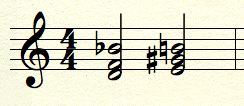The Neapolitan
In last week’s discussion of secondary dominants and previous discussions on mixture I’ve introduced everyone to chromaticism in tonal music. That is, chords that exist outside the traditionally diatonic chords found natural in any major scale. Today we add another: The Neapolitan.
Construction
The Neapolitan is a major chord build on a lowered second scale degree. Usually these chords are more frequent in minor (see below). So in A minor, our Neapolitan chord would be a B-flat major chord. Because the chord is built on the second scale degree we use a roman numeral “II” to indicated it. Because the root is altered, it has to be indicated by an accidental before the roman numeral. The Neapolitan usually occurs in first inversion, making this the most common roman numeral for it:
There’s usually the thought that the accidental before the roman numeral should reflect what actually happens to the root. So, if we had a neapolitan in B minor (a C major chord), since B minor has a C# and actually be applying a natural sign. As such, some think that we should put a natural sign in front of the roman numeral. I think that’s confusing, and usually just stick with bII6. But there’s another option! that avoids this problem entirely. Just using N6 to label a Neapolitan chord is just fine.
Usually in minor the ii chord is diminished. If we consider the scale contents (based on a major scale) of a N6 chord we find: b2 4 and b6. Minor already has a b6, so the only chromatic alteration required is lowering the second scale degree. To get a Neapolitan chord in major requires lowering the second and sixth scale degree.
Voice Leading Considerations
The Neapolitan functions just as any II chord does: it moves to dominant. However, the dominant chord (V) has a natural second scale degree which creates some problems. Sometimes it’s beneficial to avoid the melodic progression b2-natural 2 like this:
b2 has the tendency to move down. Really it wants to go to the first scale degree, but because it moves to five the most common line movement is for b2 to skip 1 and jump down to 7.
Spot of Analysis
Going back to our favorite Sor Study in B minor we find a great two measure Neapolitan moment. In B minor the Neapolitan would be C major. Usually this C major would be in first inversion which is just what Sor does in measures 29 and 30:
This C major chord eventually moves to dominant (F#) in measure 32, but first Sor throws in a diminished chord applied to the dominant (vii07 of V). This chord is similar to a secondary dominant and it functions the same way: as a dominant function chord that resolves to another. We’ll discuss diminished chords more in depth in another post.




ben
wow chris! i just started my composition for dougherty’s theory class. thought i’d search the old interweb for some help on guitar composition. your blog has been very helpful. thanks so much for the inspiration!